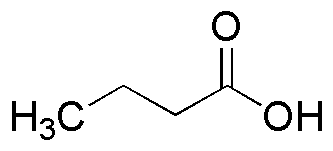Butyric acid is widely utilized in research focused on:
- Food Industry: It is used as a flavoring agent and preservative in various food products, enhancing taste while providing antimicrobial properties.
- Pharmaceuticals: Butyric acid serves as an important intermediate in the synthesis of various medications, particularly in the production of anti-inflammatory drugs.
- Agriculture: This compound is applied in the formulation of herbicides and pesticides, improving crop yield and pest resistance.
- Biotechnology: It plays a role in cell culture media, promoting cell growth and differentiation, which is crucial for research in tissue engineering and regenerative medicine.
- Cosmetics: Butyric acid is incorporated into skincare products for its moisturizing properties and ability to enhance skin barrier function.
General Information
Properties
Safety and Regulations
Applications
Butyric acid is widely utilized in research focused on:
- Food Industry: It is used as a flavoring agent and preservative in various food products, enhancing taste while providing antimicrobial properties.
- Pharmaceuticals: Butyric acid serves as an important intermediate in the synthesis of various medications, particularly in the production of anti-inflammatory drugs.
- Agriculture: This compound is applied in the formulation of herbicides and pesticides, improving crop yield and pest resistance.
- Biotechnology: It plays a role in cell culture media, promoting cell growth and differentiation, which is crucial for research in tissue engineering and regenerative medicine.
- Cosmetics: Butyric acid is incorporated into skincare products for its moisturizing properties and ability to enhance skin barrier function.
Documents
Safety Data Sheets (SDS)
The SDS provides comprehensive safety information on handling, storage, and disposal of the product.
Product Specification (PS)
The PS provides a comprehensive breakdown of the product’s properties, including chemical composition, physical state, purity, and storage requirements. It also details acceptable quality ranges and the product's intended applications.
Certificates of Analysis (COA)
Search for Certificates of Analysis (COA) by entering the products Lot Number. Lot and Batch Numbers can be found on a product’s label following the words ‘Lot’ or ‘Batch’.
*Catalog Number
*Lot Number
Certificates Of Origin (COO)
This COO confirms the country where the product was manufactured, and also details the materials and components used in it and whether it is derived from natural, synthetic, or other specific sources. This certificate may be required for customs, trade, and regulatory compliance.
*Catalog Number
*Lot Number
Safety Data Sheets (SDS)
The SDS provides comprehensive safety information on handling, storage, and disposal of the product.
DownloadProduct Specification (PS)
The PS provides a comprehensive breakdown of the product’s properties, including chemical composition, physical state, purity, and storage requirements. It also details acceptable quality ranges and the product's intended applications.
DownloadCertificates of Analysis (COA)
Search for Certificates of Analysis (COA) by entering the products Lot Number. Lot and Batch Numbers can be found on a product’s label following the words ‘Lot’ or ‘Batch’.
*Catalog Number
*Lot Number
Certificates Of Origin (COO)
This COO confirms the country where the product was manufactured, and also details the materials and components used in it and whether it is derived from natural, synthetic, or other specific sources. This certificate may be required for customs, trade, and regulatory compliance.


